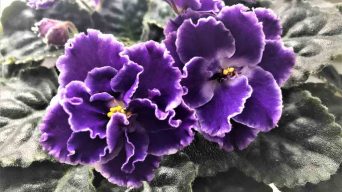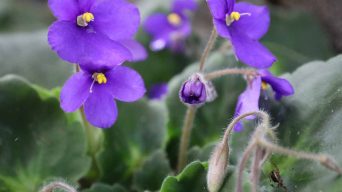African violet plants are relatively easy to care for and make a great addition to any home. These beautiful plants come in a variety of colors, and they can brighten up any space.
While they are typically healthy plants, there are times when they may become sick.
This article will teach you how to tell whether an African violet is healthy.
Signs of a Healthy African Violet
There are a few key things to consider when trying to determine if an African violet is healthy.
The most important things to look for are:
Healthy Leaves That Are Green and Free of Spots or Discoloration
When looking for signs of a healthy African violet, one of the first things you should look at is the condition of its leaves.
Healthy leaves should be a vibrant green, free from spots or discoloration. This indicates that your plant receives all the nutrients needed to thrive and grow.
Also, healthy leaves will be thick and sturdy, showing no signs of wilting or drooping, which can indicate a watering issue.
Ideally, you want to maintain African violet leaves that are green and free of any sign of distress, as this is a clear sign that your plant is well cared for and thriving in its environment.
Full, Vibrant Blooms
Another key sign of a healthy African violet is the presence of full, vibrant blooms.
African violets typically bloom seasonally, but you can encourage your plant to bloom year-round with proper care.
If you see healthy leaves and no blooms, this does not necessarily indicate an unhealthy plant, as flowers can take some time to appear.
However, notice that your African violet’s blooms are wilting or falling off prematurely. This could be a sign that something is wrong with your plant.
Ensure that your plant provides adequate light, water, and nutrients to encourage healthy blooms.
Stems That Are Firm and Upright
In addition to healthy leaves and blooms, you also want to ensure that your African violet stems are firm and upright.
If the stems are limp or drooping, this is usually a sign of overwatering.
Additionally, if you see any browning or discoloration on the stems, this could be a sign of an unhealthy plant.
To ensure healthy stems, ensure you water your African violet regularly but do not overwater it to the point of saturation.
Strong Roots That Are White or Light-colored
Strong, white, or light-colored roots indicate a healthy African violet. These roots develop as the plant takes up water and nutrients from the soil, providing it with the vital energy and stability it needs to grow.
In addition to being white or light-colored, healthy roots are typically long, thick, and well-developed, with distinct lateral branches penetrating deep into the soil.
If the roots are brown or discolored, this could be a sign that something is wrong with your plant.
Additionally, if the roots are mushy or weak, this is usually a sign of overwatering.
Overwatering is one of the most common problems people have with African violets and can quickly lead to root rot, which can kill your plant.
To avoid overwatering, make sure you are letting the soil dry out completely between waterings.
New Growth on the Plant
Finally, healthy African violets typically have new growth appearing on the plant. This can be in the form of new leaves, stems, or blooms.
Seeing evidence of new growth is a good sign that your plant is healthy and doing well.
On the other hand, if you don’t see any new growth, this could be a sign that your plant is not getting the care it needs to thrive.
To encourage new growth, ensure you provide your African violet with adequate light, water, and nutrients.
Signs of an Unhealthy African Violet
In addition to looking for signs of a healthy African violet, you should also be on the lookout for any signs that your plant might be unhealthy.
Some common signs of an unhealthy African Violet include:
Yellow or Brown Leaves
When you notice that your African violet plant has yellow or brown leaves, this is a sign that the plant is unhealthy and may suffer from nutrient deficiencies or other environmental issues.
You can do several things to help your plant regain its health and get back to producing vibrant green leaves.
One of the first things you should do is ensure you provide your plant with the correct amount of sunlight and water. Keeping it in an area that receives bright indirect light will give it what it needs to thrive while ensuring that you are not overwatering or underwatering it.
Additionally, consider adding a mild fertilizer to the soil, which can help the plant access more nutrients as it grows.
Wilting Leaves
If you notice that your African violet’s leaves are wilting, this is usually a sign of dehydration. When the leaves of the plant don’t have enough water, they will start to wilt to conserve water.
To prevent dehydration, ensure you regularly water your plant and mist it with water if the air in your home is particularly dry.
In addition to wilting leaves, you may also notice that the plant’s blooms start to droop or fade in color when it is dehydrated.
If you see any of these signs, make sure you give your plant a good watering and misting to help it recover.
Leaves That Are Falling Off
If you notice that the leaves on your African violet plant are starting to fall off, this is usually a sign that the plant is not healthy.
There are several reasons why this might happen, including dehydration, nutrient deficiencies, or pests.
To help your plant recover, ensure you water it regularly and mist it with water if the air in your home is dry. Consider adding a mild fertilizer to the soil to help the plant access more nutrients.
If you suspect pests might be the problem, you can try using an insecticidal soap or neem oil to get rid of them.
Spots on the Leaves
When you notice spots on your African violet plant leaves, this is usually a sign of a fungal or bacterial infection.
Brown spots on African violet leaves can be caused by several different fungi, including Botrytis and Alternaria. These fungi thrive in warm, humid environments and can quickly spread to other plants if not controlled.
To prevent the spread of these diseases, ensure you are providing your plant with adequate air circulation and not overcrowding it. Consider using a fungicide to help control the spread of the disease.
If you notice any white spots on the leaves, this is likely due to a bacterial infection. Bacterial diseases are often more challenging to control and can quickly kill a plant if not treated.
If you notice any spots on the leaves of your African violet plant, isolate the plant from other plants and contact a professional for help.
Leggy Growth
When you notice that your African violet plant is starting to grow leggy, this is usually a sign that it is not getting enough light.
Leggy growth happens when the plant stretches to try and reach more light, resulting in long, thin stems.
Ensure you provide your plant with bright indirect light to prevent leggy growth. If the plant needs more light, you may also notice the leaves turning yellow or pale.
If you see any of these signs, move your plant to a brighter location.
Stunted Growth
If your African violet plant’s growth is stunted, this is usually a sign of a nutrient deficiency.
One of the most common nutrient deficiencies in African violets is nitrogen, which can cause the leaves to turn yellow or pale.
A lack of phosphorus can also cause stunted growth and a lack of blooms.
To prevent nutrient deficiencies, use a well-balanced fertilizer and not over or underwater your African violet plant.
If you suspect a nutrient deficiency is a problem, use a fertilizer with higher nitrogen levels, phosphorus, or both to help the plant recover.
Drooping Flowers
When the flowers on your African violet plant are drooping or fading in color, this is usually a sign of dehydration.
To prevent the flowers from drooping, ensure you are regularly watering the plant and misting it with water if the air in your home is dry.
In addition to drooping flowers, you may also notice that the leaves on your plant start to wilt or fade in color when it is dehydrated.
If you see any of these signs, make sure you give your plant a good watering and misting to help it recover.
How To Keep Your African Violet Healthy
African violets are a beautiful and popular houseplant. They are not difficult to grow, but there are a few things you need to do to keep them healthy.
Some tips for keeping an African violet healthy are:
- Give them bright indirect light. They can tolerate some direct sunlight, but too much will scorch their leaves.
- Water them when the soil is dry to the touch. Over-watering can lead to root rot, so let the soil dry out completely between waterings.
- Fertilize during the growing season. Use a water-soluble fertilizer designed for African violets.
- Use a well-draining potting soil mix. African violets must be in well-draining soil to prevent the roots from sitting in water.
- Prune away any dead or dying leaves. This will help encourage new growth.
- Repot every year or two. African violets need to be in a pot that is just big enough to accommodate their root ball.
Following these tips can keep your African violet healthy and blooming for years.
Final Thoughts
Knowing how to tell if your African violet is healthy or not is essential for keeping your plant happy and vibrant.
By paying attention to the leaves, flowers, and root system, you can quickly identify any problems that may be developing.
With some care, you can ensure that your African violets stay healthy for years to come!







